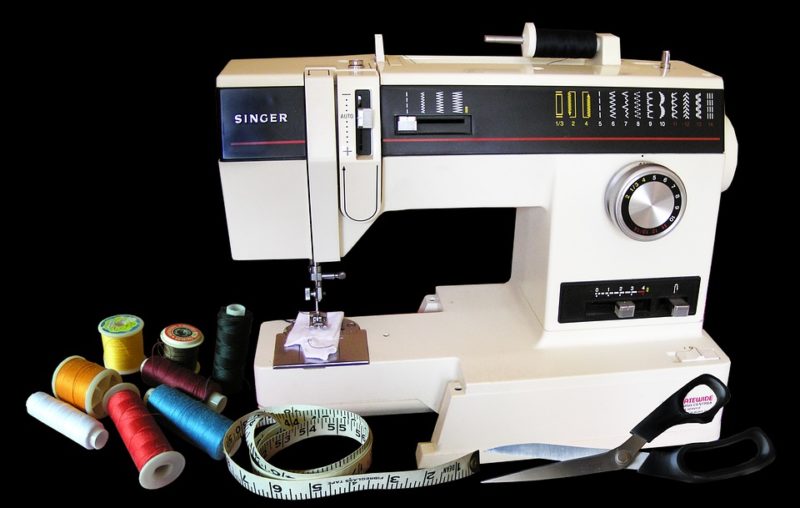Let us discuss the parts of a sewing machine and what they do by starting with the nine basic ones. Then, we’ll go through their functions and importance.
We also recommend reading how a sewing machine works further to understand this unit’s mechanism as a whole. Feel free to browse our blog as well for other topics regarding the sewing machine and its parts.

What Are The Main Parts Of A Sewing Machine And What They Do?
As pointed out by the College & Career Alliance and Support Network (CCASN) at UC Berkeley, sewing machines will always have basic parts found in all models regardless of how they differ. However, please still consult your manual as it will have an illustration pointing out its features.
Here are the main parts of the sewing machine found in old and modern models:
Needle
The needle of the sewing machine functions as how you use a needle for hand-sewing. It goes through the fabric to form stitches, and some models even use a so-called twin or double needle.
There are also different types of sewing machine needles because various fabrics call for specific needle sizes. Please remember that it’s crucial to know how to change the sewing machine needle after every project or 8 hours of use to ensure perfect stitches.
Throat plate
The metal plate underneath the needle and presser foot is the throat plate. In some manuals, this is also called the needle plate, and it has an opening where the needle passes through when sewing.
You can also find notches on the throat plate, which are guides for sewing straight lines. You can even use these guides to get perfect seam allowances.
Bobbin
The needle is not the only part of the sewing machine that gets threaded. For example, when setting the machine, you’ll also wind and thread the bobbin or the lower part of the sewing machine.
The bobbin can either be front-loading or drop-in, and it’s composed of the bobbin case, cover, and winder other than the bobbin itself. These components are responsible for the underside stitch.
When cleaning and oiling the sewing machine for maintenance, the bobbin area is among the parts that need both. Just consult your manual on which component needs lubrication and avoid using bobbins that are not recommended for the specific model you have.
Spool pin
The thread goes on the spool pin of the sewing machine. This part holds the thread spool during sewing for smooth feeding of the thread.
Sewing machines can either have a horizontal or vertical spool pin, where the former is often preferred for its stability. Additionally, remember that every thread spool will use a specific spool pin, and you may need to improvise if your spool is larger.
Presser foot
The spool pin holds the thread spool while the sewing machine uses the presser foot to hold the fabric. This way, the material won’t move as you sew for precise placement and sizes of stitches.
We have discussed the different types of sewing machine attachments and how to use them. In there, you’ll find that there are various presser foot for different tasks and projects.
Feed dogs
You will find the feed dogs as the teeth responsible for pulling the fabric while sewing with the sewing machine. It helps with the smooth feeding of material between the presser foot and needle plate.
The feed dogs are also what allows the machine to regulate the stitch length. This is possible by controlling how much fabric passes through.
Tension regulator and thread guides
The sewing machine tension is adjustable thanks to the tension regulator. By moving the regulator higher or lower, you can loosen or tighten the stitches as needed.
But for the regulator to work, you need to thread the sewing machine correctly and check if you passed through the loops called thread guides shown in the manual. The thread must go through the thread guides according to the order dictated by the manual.
Take-up lever
The take-up lever of the sewing machine is responsible for pulling the thread from the spool when sewing. You can find it above the presser foot because it will also lift the thread from the cloth after stitching.
You will find that threading the sewing machine requires it to pass through the take-up lever. Please follow the manual to locate it when threading.
Handwheel and foot pedal
The sewer can efficiently control their sewing machine with the handwheel and foot pedal. The wheel raises and lowers the take-up lever while pressing the pedal controls how fast you make stitches.
Improper setup of the sewing machine can cause issues with the handwheel. On the other hand, problems with the foot pedal might warrant a visit to a repair center.
Conclusion
And that’s it! We’ve just discussed the nine parts of a sewing machine and what they do. These are the essential parts of all sewing machines; needle, throat plate, bobbin, spool pin, presser foot, feed dogs, tension regulator, take-up lever, and the handwheel and foot pedal.
Always check these parts if they need repair or cleaning. Then, consult your manual for how to use them and bring your machine to an authorized dealer for complex issues to avoid worsening damages, if there are any.
